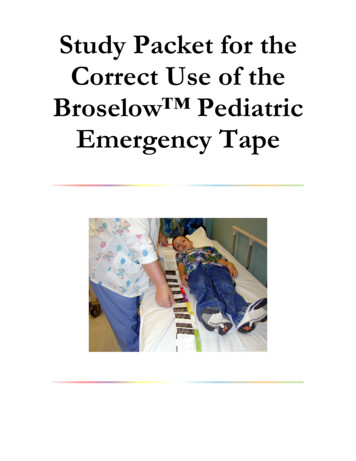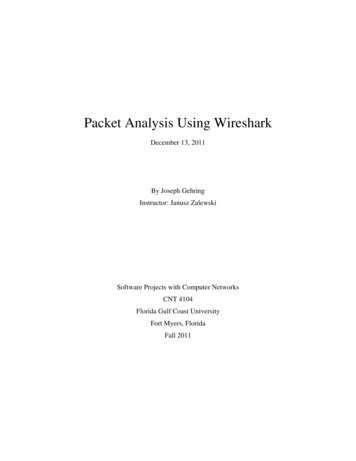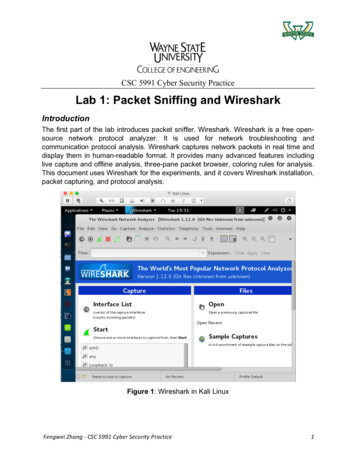
Transcription
Study Packet for theCorrect Use of theBroselow PediatricEmergency Tape
Study Packet for the Correct Use of theBroselow Pediatric Emergency TapeEnhancing Pediatric SafetyDuke University Medical Center, Karen Frush, M.D., P.I.Emergency Medical Services for ChildrenThis project funded by the Department of Health and Human Services HealthResources and ServicesAdministration Maternal Child Health Bureau Grant # 5 H70 MC 00002-02
How to use this Study PacketThe purpose of this study packet is to introduce the learner to the Broselowtape and describe how to use the Broselow Tape correctly and effectively.Included in this study packet are several case-based scenarios that will test thelearner’s understanding of how to use the tape within the framework of severaltypical pediatric emergencies.In order to use this study packet effectively, the learner should have thefollowing items available for reference: The Broselow Pediatric Emergency Tape Edition The Color-Coded Acute Book (CAB) A stopwatch or a watch with a second hand (optional)Answers to any of the questions you may be asked while using this packet willbe found at the end in Appendix 1.If you need to refresh yourself on a relevant calculation, pertinent calculationsare referenced in Appendix 2.Learning Objectives1. The learner will briefly describe the Broselow-Luten Color Coding System(B-LPS), its history and rationale for use.2. The learner will demonstrate how to correctly place the Broselow Pediatric Emergency Tape using appropriate landmarks and exhibitingproper alignment with the correct (color-coded/weight) side visible3. The learner will identify the correct color zone for the child and properlyidentify correct equipment sizes.4. The learner will identify the proper dosage for several case appropriatemedications.5. The learner will describe the child’s color zone as a “6th vital sign”.1
Description of the Broselow TapeThe Broselow PediatricEmergency Tape [Figure 1] providesa tool for determining the correctdosage of medications and equipment sizes(endotracheal tubes, suction catheters, etc.)for children, based on their length. It canhelp simplify some of the decision-makingin an emergency by eliminating the need toestimate a child’s weight, which is typicallyused to calculate the correct dosage for amedication. In an emergency, the estimationof a child’s weight and drug dosagecalculation is done under stressfulconditions, increasing the likelihood ofdosage errors. Research has already shownthat the dosage calculation in the pediatricsetting is highly prone to errors.1,2,3,4,5,6Additionally, patient weight in the pediatricpopulation is critical for dosing formulas,but evidence suggests that both physicianand nurse estimates of children’s weights areunreliable ( 15% off).7Figure 1: Section of the Broselow Pediatric Emergency Tape2
A brief exampleJonathan, an 8 year old boy is brought to the emergency department by hisfather. Jonathan has had persistent vomiting and diarrhea for the past threedays. Jonathan has also had almost no intake during this time frame. Hisfather states that Jonathan has no significant previous medical history. Thechild has no known allergies and is not on any current medications. His fatherguesses the Jonathan weighs about 45 pounds (His actual scale weight onadmission is 31.3 lbs).Labs are drawn on the child and a fingerstick serum glucose level is done at thesame time. Jonathan’s serum glucose is 50 mg/dL. Although there are certainlyadditional assessment criteria and interventions that need to be addressed here,it is apparent that the child needs dextrose.Administer Dextrose 25% IV. (If you are unfamiliar with the calculationfor this, you may refer to Appendix 2 for the relevant calculation.)(If you are using a stopwatch or have a watch with a second, you mighttime yourself to see how long it actually takes to determine this calculation).Q1. How many kilograms does this child weigh?(answers at the end of this packet in Appendix 1)Q2. How much D25% does this child need? (cc’s)1. How much time do you think it would have taken to weigh the child?2. Did you remember the calculation to determine the dose of dextrose to giveto this child?3. Did you have to convert the weight from pounds to kilograms?4. Did you have to take in account the specific concentration of drug to beadministered?5. How long did it take to calculate the correct dosage?6. Are you sure that particular dosage was correct?7. How long would it take to draw up and administer the dosage?3
Rationale for using a color-coded systemAs you can see, medication administration to a pediatric patient involvesmany factors. Medication dosages typically are based upon the child’sweight in kilograms. To provide the proper dosage of a medication tothe child, the practitioner must know the child’s weight, the dose per kilogram,and the available concentrations of the specific drug. Pediatric resuscitationdrugs are not used often enough to recall the correct dosage, and valuable timeis taken to look up the correct dosage by weight. Calculations required mayinclude conversion of weight from pounds to kilograms, as well as dose byweight and concentration ofthe drug.By using a color-coded systemtool, the practitioner is able toconcentrate on moreimportant factors of careduring the emergency, such assecuring the airway,maintaining circulation,making a diagnosis andsecuring appropriatetransport. The lengthmeasurement is taken directlyfrom the child and a color isFigure 2: Example of Pediatric Equipment grouped by colorassigned. The practitionerdoes not need to rely on memory or calculations toselect the appropriate size equipment or drugdosage. Equipment and even medications can beorganized and stored by color to permit easier accessin an emergency [Figure 2-3].Figure 3: Example of PediatricEquipment grouped by color4
History of the Broselow Pediatric Emergency TapeThe original tape was the invention of Dr. Jim Broselow [Figure 4], anemergency physician in Hickory, North Carolina. By his ownadmission, as a family physician he felt pretty comfortable withcaring for very sick adults, but when the patientwas a critically ill or injured child, he describeschaos, terror and lack of confidence on the part ofemergency care providers. He was sure that therewas a better way to care for these children thatwould provide consistency and standardization. Dr.Broselow developed a simple tool to increase theaccuracy of weight estimation using height-weightcorrelations from the National Center for HealthStatistics (NCHS)9. The Broselow PediatricEmergency Tape has become an industry standardin pediatric emergency care. 8,9,10,11,12,13Figure 4: Dr. Jim BroselowAfter the development of the original tape, Dr.Broselow teamed up with Dr. Bob Luten, a Pediatric Emergency Physicianfrom Jacksonville, Florida. Together, with the input of other colleagues, theyhave developed the latest tape and other items that enhance the system. Itsdevelopment is based on more than 20 years of emergency department use.Use of the tape has been the subject of several studies that validateits use. 8,9,10,11,12 Analysis shows that mean medication dosing error severitywhen subjects used the B-LPS was 33.88% lower then when B-LPS was notavailable. 13The tape may is recommended for use on any child under the age of 12 yearsold. For any child that is longer than the tape, the practitioner should use adultdosages and equipment.5
How to properly use the Broselow PediatricEmergency TapeIn order for the Broselow Pediatric Emergency Tape to be truly effectivefor the calculation of drug doses and equipment size in the pediatricpopulation, it must be used correctly. The following steps demonstratehow to use the tape correctly.1. Place the Broselow Pediatric Emergency Tape on a flat surface withthe color-coded/weight side visible [Figure 5].Figure 5: Color-coded/Weight side UpWeights2. Place the red end of the tape even with the top of the patient’s head[Figure 6].Figure 6: Red end of Broselow Pediatric Emergency Tape6
3. The following illustrates proper placement of the tape at the head of apatient [Figure 7]. Remember “RED to HEAD!”Figure 7: Proper placement of Red end of tape at top of head4. Place one hand at the top, with the edge of your hand resting in the redbox at the red end of the tape [Figure 8].Figure 8: Proper hand placement at head of patient7
5. Run your free hand down the tape from the patient’s head [Figure 9]. It isimportant to maintain proper placement at the head of the patient.You may have someone assist you if necessary. Never measure a childin the seated position.Hand runningalong thelength of thetape fromhead topatient’s heel.Figure 9: Moving hand to find proper color zone6. Stop free hand at the bottom of the patient’s heel (not the toes). Theedge of the free hand that lands on the tape adjacent to the patient’sheels indicates the patient’s approximate weight in kilograms and thepatient’s color zone [Figure 10].Hand on tapeadjacent topatient’s heelidentifyingpatient’sweight andcolor zone .Figure 10: Identification of Color Zone and Weight8
For this particular patient his heels are adjacent with this area on the tape(marked in the following illustration with a line) [Figure 11].Figure 11: Identification of Color ZoneQ3. What color zone is this child in?(answers at the end of this packet in Appendix 1)7. If the child is longer/larger than can be measured with the tape ( 34kgs.), stop and proceed as you would with an adult patient.8. Be sure to verbalize and document both the color zone and the weightof the child. The color zone can be thought of as a sixth vital sign.Summary - Proper use of the tape1. Place the red end of the tape even with the top of the patient’s head.Remember "Red to Head". The child should be lying down. Nevermeasure a child in a seated position.2. Place one hand at the top, with the edge of your hand resting in the redbox at the red end of the tape.3. Run your free hand down the tape from the patient’s head. It isimportant to maintain proper placement at the head of the patient. Youmay have someone assist you if necessary.9
4. Stop free hand at the bottom of the patient’s heel (not the toes). Theedge of the free hand that lands on the tape adjacent to the patient’sheels indicates the patient’s approximate weight in kilograms and thepatient’s color zone.The Color-coded Acute BookThe color-coded Acute Book [Sample - Figure 12] is also a handy reference. Theclinician can get additional information from the Acute Book includeequipment sizes, dosing information and Color Zone information.Figure 12 – Color-coded Acute Book (CAB)Case StudiesThe following case studies are given as examples of the use of theBroselow Pediatric Emergency Tape. You will need yourBroselow Pediatric Emergency Tape and the Color-Coded AcuteBook to complete these case studies. You may use either the tape orthe Acute Book to assist you in answering the case study questions.Brief questions are asked throughout the case presentations. Answersto all questions follow at the end of this study guide in Appendix 1. Ifyou need to look up a calculation relevant to these case studies,relevant calculations are found in Appendix 2.10
Case Study 1:Michael is nine month old white male whose mom has called 911because she is having difficult “waking him up” this morning.On initial assessment the child seems unaware of his surroundings, although hiseyes are open and staring. He has decreased work of breathing, and his color ispale. He appears quite small for his stated age. PMH is significant for failure tothrive with a previous hospitalization. Mom reports no substance ingestion, noother history. Child has no allergies that she is aware of.Vital signs are taken including the child’s color zone using the Broselow Pediatric Emergency Tape. This particular patient’s heels are adjacent with thisarea on the tape (marked in the following illustration with a line) [Figure 13].Figure 13: Identification of Color ZoneQ4. What color zone is this child in?(answers at the end of this packet in Appendix 1)11
This child requires immediate intervention. Your first priority should be oxygendelivery.Q5. What delivery method?Q6. If choosing mask, what size?Vital signs: Color Zone – ? , Think of Color Zone as the 6thVital Sign. Respiratory Rate 16; heart rate 160; central pulses intact, peripheralpulses are weak. Skin is pale and cool to touch. Mom is not sure how much heweighs but he has always been “really skinny”.Cardiac monitor shows sinus tachycardia. Lungs are clear.IV access is established and a 120cc (6kg x 20cc) fluid bolus of warm normalsaline via 20 cc syringe with a 3-way stopcock.Dextrostick 38 mg/dL.The next intervention should be the administration of D25%.Q7. This child is in the pink zone on the Broselow Tape. Whatwould be the appropriate amount of D25W to administer(cc’s.)?(Note: The Glucose administration guidelines on the tape do NOT apply to overdose situationsonly. If your unit only stocks D50, you will need to dilute the D50 to make D25).After administration of D25W child begins to cry slightly. Heart rate afterD25% and 60 cc of fluid is 150. Respiratory rate is 22 with crying. Color isstill pale, skin slightly warmer to touch.Further intervention should be to continue the fluid bolus, repeat dextrostick.Repeat reading is 60 mg/dL. Consider repeat of 2 ml/kg (12 cc) of D25%.This child needs hospital evaluation, social services intervention and closemonitoring.12
Rationale:In infants, hypoglycemia is a blood glucose level below 40. It is evidenced ininborn errors in metabolism, problems of defects in carbohydrate metabolism,organic acid disorders, and defects in fatty acid oxidation. Presenting symptomscan be lethargy, tachycardia, seizures, dysrhythmias.An article related to this information: Lteif, A.& Schwenk, W. (1999). Hypoglycemia in infants and children.Endocrinology Metabolism Clinics of North America 28 (3), 619-646.13
Case Study 2:Grace is an 8 year old Asian-American female who has an allergy topeanuts. She is in the hospital cafeteria eating with her family whileher mother is visiting her aunt. Her father noticed that just afterGrace has bit into her cookie, she began to develop some swelling of her lipsand her “breathing sounds kind of wheezy”. He usually carries an epi-pen forGrace, but they left the house in a hurry when her aunt got sick and he can’trecall bringing the pen. Dad calls out for help. By the time you arrive as partof an emergency response team, Grace is gasping for breath, her eyes are openand frightened, wheezing is audible and there is increased work of breathing.Her lips are pale. It appears that there are raised areas on her skin.Vital signs are taken including the child’s color zone using the Broselow Pediatric Emergency Tape. This particular patient’s heels are adjacent with thisarea on the tape (marked in the following illustration with a line) [Figure 14].Figure 14: Identification of Color ZoneQ8. What color zone is this child in?(answers at the end of this packet in Appendix 1)14
Vital signs: Color Zone – ? ,HR 140, RR 32 with wheezingaudible, BP 90/58. Cardiac monitor shows sinus tachycardia.Q9. Oxygen delivery is a priority. According to the Broselow tapewould you use an adult or Pediatric O2 mask?Her vital signs are abnormal for her age and Color Zone. Advanced LifeSupport equipment and medications are available. What is your nextintervention?Continue oxygen delivery. If airway compromised, employ advanced airwaymanagement as necessary. Her presentation is consistent with anaphylaxis.Q10. What would be the dose of subcutaneous epinephrine shewould require (mg)?IV access is established and a fluid bolus of warm normal saline is given(560cc). Diphenhydramine HCL (Benadryl) Orange dose 25 mg via deepintramuscular injection IV push is also administered.After administration of the subcutaneous epinephrine, the patient becomesunresponsive. Her work of breathing is decreased; wheezing is still audible, lipsand nailbeds are pale.Heart rate is 160, RR is 20, BP is 90/58.The patient is in shock. She requires assisted ventilation with an adult sizemask and ventilation bag.Q11. What is the resuscitation dose of epinephrine 1:10,000 IV forthis patient according to her color zone (cc’s)?Q12. What type of ET tube should be used forintubation?Q13. What would be the required IV dose ofMethylprednisone?15
After administration of IV epinephrine, patient is slightly more arousable,HR 160 RR 24, wheezing decreased, BP 100/78. She is transported to theEmergency Department for further evaluation and stabilization.Rationale:Anaphylaxis is an acute, generalized antigen-antibody reaction that canbe rapidly fatal. An anaphylactic reaction may present as a mild to severeresponse: management is based upon severity. Anaphylaxis in children isunusual. As in adults, there are multiple causes of anaphylaxis: injectedsubstances or drugs such as penicillin; other causes include foodsensitivities, vaccines, insect stings.Hypotension in children is uncommon. Shock should be assessed basedon level of consciousness, work of breathing and “skin signs”.Wheezing is another feature of anaphylaxis. Most reactions occur withinthirty (30) minutes following allergen exposure, although the onset ofsymptoms can vary from several seconds to hours. As a rule, the earlierthe onset of symptoms following antigenic exposure, the more severewill be the subsequent reaction. Virtually all body systems are affected inan anaphylactic reaction.Article to read:Pediatric Anaphylaxis: Jeffrey Linzer, MD as found at:http://www.emedicine.com/emerg/topic360.htm16
Case Study 3:Justin is a 3 year old male child whose mother states that the child fell off ofa very tall slide on the playground a few minutes ago. He didn't move "for acouple of minutes" and has been acting very sleepy since then. He is lyingquietly in his mother's arms, and is breathing spontaneously. There is somedried blood on his face.Assessment reveals that the child is unresponsive to pain, breathing is slightlydecreased, and color is pale. His airway is open, no abnormal airway noises,respiratory rate is 24 and shallow, a little bluish tint is around his mouth.He has a potential C-spine injury and requires immobilization. This child is inneed of emergent care. Appropriate team members are available to assist youand universal precautions are assumed.Vital signs are taken including the child’s color zone using the Broselow Pediatric Emergency Tape. For this particular patient his heels are adjacentwith this area on the tape (marked in the following illustration with a line)[Figure 15].Figure 15: Identification of Color ZoneQ14. What color zone is this child in?(answers at the end of this packet)17
Vital signs: Color Zone – ? Cardiac monitor shows sinustachycardia. Lungs are clear. Child’s heart-rate is 160, BP is 98/58.Temperature is 36 C . Respirations are assisted at 20 per minute.Immediate oxygen delivery is required.Q15. What delivery method would you use?Q16. If choosing a mask, what size?The child's clothing is removed and there are no obvious signs of bleeding.Appropriate warming measures (blankets, lights) are applied.The mother provides additional history (no PMH, on no medications, noallergies) and is in need of additional feedback and support.Additional assessment reveals that the only other abnormality is a swollen leftthigh area. There is also a small amount of blood in each nares. He has goodrectal tone with no evidence of bleeding.IV access is obtained and a purple zone fluid bolus of warm normal saline of200cc is administered via 20 cc syringe with 3 way stopcock.Q17. What would be the IV catheter size for thischild?Peripheral IV attempts proved to be unsuccessful. The child is prepared for anintraosseous line (2 fingerbreadths below tibial tuberosity on unaffected leg).Appropriate trauma labs (CBC, Type and Cross), Appropriate traumaradiographs (XTL C-Spine, CXR, Pelvis), and a Head CT (may also order abd.CT) are ordered and complete.18
The child has a gag reflex and rapid sequence intubation is ordered.Q18. According to the patient’s color zone, what size ET tubewould be appropriate?Q19. What size stylet?After intubation, vital signs are reassessed (a little more difficult to ventilate,abdomen is slightly distended; heart rate 140, RR 24 assisted, pulse ox 96% BP98/54).An NG tube is ordered.Q20. According to the Broselow Pediatric Emergency Tape,what size NG tube would be appropriate?Child is transported to the CT scanner without incident and the mother isreassured.Student les/pdf/trauma.pdf19
Summary and EvaluationHopefully, you have found this information on the Broselow PediatricEmergency Tape useful and interesting. There are several keypoints that youshould remember:When used correctly the Broselow Pediatric Emergency Tape is an excellenttool that will reduce medication and equipment errors in the pediatricpopulation.In order to place the tape correctly.1. Place the red end at the top of the patient's head.2. Rest one hand at the top of the tape and slide your other hand down thetape to the heel of the patient. Be sure to maintain the position of thehand at the top of the head.3. Measure the patient's color zone at the heels NOT the toes.That is all there is to it.In order to receive credit for this course, you must complete the evaluation.The evaluation is available as a separate document. You may also review ourreferences, which are located on at the end of this document.20
Appendix 3.Q14.Q15.Q16.Q17.Q18.Q19.Q20.31.3/2.2 14.23 kg14.23 x 2 28.5 ccBluePinkFace MaskInfant12 mlOrangeAdult3.0mg SQ2.8 mL6.0 mm cuffed25 mgPurpleFace MaskPediatric20 – 24g catheter4.0mm uncuffed6F8-10F21
Appendix 2Calculations:Q1-2. The calculation for D25% is 2cc/kgQ7. The calculation for D25% is 2cc/kg22
References1. Rowe C, Koren T, Koren G. Errors by pediatric residents in calculating drug doses.Archives of Disease in Childhood. 1998 Jul;79(1):56-58.2. Lesar TS. Errors in the use of medication dosage equations. Arch Pediatr Adolesc Med.1998;152:340-344.3. Koren G, Barzilay Z, Greenwald M. Tenfold errors in administration of drug doses: Aneglected iatrogenic disease in pediatrics. Pediatrics. 1986 Jun;77(6):848-849.4. Perlstein PH, Callison C, White M, et al. Errors in drug computations during newbornintensive care. American Journal of Diseases of Children. 1979 Apr;133(4):376-379.5. Kausahal R, Bates DW, Landrigan C. Medications errors and adverse drug event inpediatric inpatients. JAMA. 2001;285:2114-2120.6. Potts MS, Phelan KW. Deficiencies on calculation and applied mathematics skills inpediatrics among primary care interns. Arch Pediatr Adolesc Med. 1996;150:748-752.7. Harris M, Patterson J, Morse J. Doctors, nurses, and parents are equally poor at estimatingpediatric weights. Pediatric Emergency Care. 1999 Feb;15(1):17-18.8. Lubitz DS, Seidel JS, Chamcides L, et al. A rapid method for estimating weight andresuscitation drug dosages from length in the pediatric age group. Annals of Emerg Med1988 Jun;17(6):576-581.9. Hamil PW, Drizl TA et al. Physical Growth: National Center for Health Statisticspercentiles. Am J Clinical Archives 1979;32:607-629.10. Luten RC, Wears RL, Broselow J et al. Length-based endotracheal tube and emergencyequipment in pediatrics. Ann Emerg Med. 1992 Aug;21(8):900-904.11. Luten RC, Wears RL, Broselow J et al. Length-based endotracheal tube and emergencyequipment in pediatrics. Ann Emerg Med. 1992 Aug;21(8):900-904.12. Luten, RC, Wears RL, et al. A Color-Coded Pediatric Therapeutic and Patient SafetySystem: The Broselow-Luten System. Submitted to Pediatrics, June 2001.13. Shah A, Frush KS, Luox. Reduction in error everity associated with use of a pediatricmedication dosing system: A crossover trail. Submitted to JAMA, June 20, 2001.23
Jun 20, 2001 · Broselow Pediatric Emergency Tape. You will need your Broselow Pediatric Emergency Tape and the Color-Coded Acute Book to complete these case studies. You may use either the tape or the Acute Book to assist you in answering the case study questions. Brief quest











